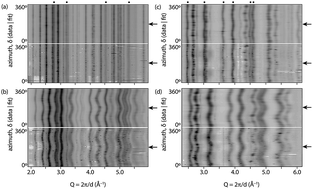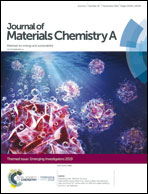Lattice strain and texture analysis of superhard Mo0.9W1.1BC and ReWC0.8via diamond anvil cell deformation†
Abstract
Mo0.9W1.1BC and ReWC0.8 compositions have recently been identified to have exceptional hardness and incompressibility. In this work, these compositions are analyzed via in situ radial X-ray diffraction experiments to comparatively assess lattice strain and texture development. Traditionally, Earth scientists have employed these experiments to enhance understanding of dynamic activity within the deep Earth. However, nonhydrostatic compression experiments provide insight into materials with exceptional mechanical properties, as they help elucidate correlations between structural, elastic, and mechanical properties. Here, analysis of differential strain (t/G) and lattice preferred orientation in Mo0.9W1.1BC suggests that dislocation glide occurs along the (010) plane in orthorhombic Mo0.9W1.1BC. The (200) and (002) planes support the highest differential strain, while planes which bisect two or three axes, such as the (110) or (191), exhibit relatively lower differential strain. In ReWC0.8, which crystallizes in a cubic NaCl-type structure, planar density is correlated to orientation-dependent lattice strain as the low-density (311) plane elastically supports more differential strain than the denser (111), (200), and (220) planes. Furthermore, results indicate that ReWC0.8 likely supports a higher differential stress t than Mo0.9W1.1BC and, based on a lack of texture development, bulk plastic yielding is not observed in ReWC0.8 upon compression to ∼60 GPa.

- This article is part of the themed collection: Journal of Materials Chemistry A Emerging Investigators


 Please wait while we load your content...
Please wait while we load your content...
